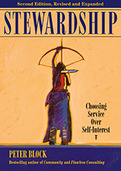BK Blog Post
Five Self-Reliant Mini-Communities
 Posted by
Jeevan Sivasubramaniam,
Vice President, Editorial,
Berrett-Koehler Publishers Inc.
Posted by
Jeevan Sivasubramaniam,
Vice President, Editorial,
Berrett-Koehler Publishers Inc.
In Sarah Van Gelder's latest book, she explores how smaller communities that are very much under the radar and yet thriving despite the "outside" world's most common ravages: inequality, unsustainability, and insecurity. There are actually quite a number of such communities scattered all throughout the nation. Here are just five you've probably never heard of:
1. The Three Rivers Recreational Area: About an hour's drive from Bend, OR, you'll encounter the 4,000 or so acres that make up this community--with about 500 homes. Some of the homes cost millions while others are just basic cabins but they all share one trait: none of them is connected to the power grid. All of the homes use solar panels, wind turbines, and back-up generators. There is no "regular" water supply either. Some homes have (or share) wells, while others have water delivered.
2. Breintenbush: Most popularly known as a retreat center and spa, this region also houses 60 community members who help to run the place. Established on about 1,540 acres near Detroit, OR. About 60 people live here permanently. The income from the center is what pays all members' wages and salaries while an onsite hydropower plant supplies electricity while geothermal wells provide heat.
3. Earthaven: Home to about 60 people working in Black Mountain, NC, all buildings are powered by solar panels and hydropower generated by a micro-hydro system in Rosy Branch Creek. Residents catch water off of roofs for use in irrigation and farming vegetables and other crops. The community is about 300 acres with plans to become a village of at least 150 people.
4. Emerald Earth: Situated on almost 200 acres of land in Mendocino County, CA, the fourteen or so people living here share a common house with a main kitchen, eating and meeting areas, and shower. There is also a bathhouse/greenhouse with a sauna, showers and garden greenhouse, as well as animals and livestock. There are four small cabins heated by passive solar and wood stoves. Solar panels and a gas generator provide electricity. Use of composting outhouses means there is no need for a septic system. The community is entirely self-sufficient for power, food, water, and all other needs.
5. The Greater World Community: Located near Taos, New Mexico is the world's first Earthship subdivision. An Earthship is a passive solar house made of natural and recycled materials. The houses themselves are very reasonably priced: a two-bedroom, one-bath Earthship with solar hot water system and six solar photovoltaic panels sells for under $300,000. Residents of the Greater World have access to 347 acres of community land, open green space with hiking, biking, parks, and community activities and events.






